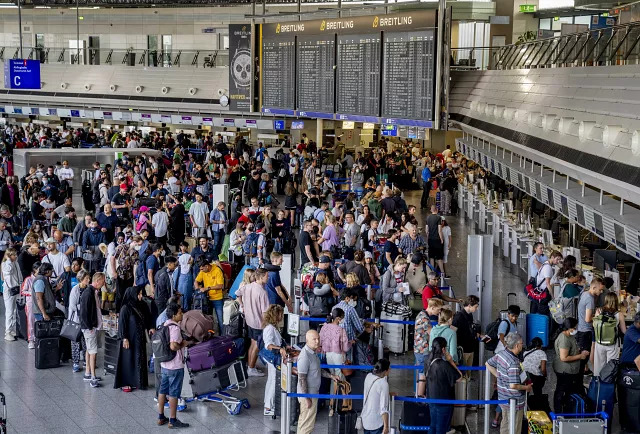On September 20, 2025, European air travel faced one of its most significant technology-driven crises in recent memory. A ransomware attack on Collins Aerospace, a key third-party provider of aviation software, disrupted operations across multiple major airports, including London Heathrow, Brussels, Berlin Brandenburg, Dublin, Cork and London City. The attack resulted in flight delays, cancellations, and long passenger queues, revealing the fragility of interconnected aviation systems when a single digital node is compromised. Beyond Europe, the incident serves as a stark reminder to global aviation stakeholders, including India, of the critical importance of digital resilience in the modern air transport ecosystem.
Anatomy of the Attack
According to statements from the European Union Agency for Cybersecurity (ENISA), the attack exploited vulnerabilities in Collins Aerospace’s MUSE software, widely used by airports for operational functions. While Collins Aerospace has reportedly entered the final stages of system restoration, the disruption exposed a systemic risk: the concentration of multiple high-traffic airports depending on a single vendor without adequate redundancies.
Government agencies across the UK, Germany, Belgium, and the EU mobilized immediately. The UK’s National Cyber Security Centre (NCSC), collaborating with the Department for Transport, law enforcement and Collins Aerospace, prioritized containment, assessment and restoration. Notably, Collins Aerospace and associated authorities exercised disciplined communication restraint during the initial 24 hours. This approach reflected a critical crisis management principle: prioritizing coordinated response and operational continuity over immediate disclosure, which could exacerbate public concern or compromise investigations.
Operational and Human Fallout
The human and business impact was profound. Brussels Airport cancelled approximately 60 of 550 scheduled flights, with disruptions continuing over subsequent days. Berlin Brandenburg passengers faced hour-long delays at departure gates, while Heathrow experienced delays and partial cancellations. Dublin and Cork airports, although less severely affected, had to revert to manual procedures, stretching staff and passengers alike.
The incident vividly illustrated the cascading effect of disruptions in interconnected aviation networks. The failure of a single vendor system not only delayed passengers but also affected airlines’ operational efficiency, ground handling, and cargo logistics. The economic and reputational costs were immediate and significant, underscoring the stakes for governments, airport operators and service providers alike.
Lessons from Global Precedents
The Collins Aerospace incident is not an isolated event. The aviation and logistics sectors have long been susceptible to cyberattacks, with each crisis reinforcing key vulnerabilities. In 2017, the NotPetya malware disrupted Maersk’s global shipping and impacted airport systems, demonstrating how malware can cripple physical trade and transportation flows. In 2019, San Francisco International Airport suffered a ransomware-induced internal systems outage. More recently, in 2023, a major airline’s IT systems failed worldwide due to ransomware, leading to widespread cancellations.
These events collectively highlight the growing interdependence of IT systems and critical infrastructure. They demonstrate that operational resilience today depends not only on in-house cybersecurity but also on rigorous oversight of third-party vendors.
Strategic Takeaways for Aviation and Logistics
The Collins Aerospace ransomware incident presents several lessons for aviation regulators, operators, and SMEs in the broader logistics ecosystem. First, overreliance on a single technology vendor creates systemic vulnerabilities. Airports and related service providers must implement robust vendor risk assessments, continuous monitoring and compliance audits, extending beyond contractual obligations.
Second, redundancy is paramount. Airports equipped with alternative systems or effective manual fallback protocols were better positioned to manage disruptions. Investment in parallel IT infrastructures, rapid failover mechanisms and offline backups is essential to ensure operational continuity.
Third, crisis management protocols must be integrated and regularly rehearsed. The measured response of Collins Aerospace prioritizing containment before public communication demonstrates the value of tested incident response playbooks. Coordination across government agencies, regulators, and private operators is critical, especially for incidents with cross-border implications.
Finally, cybersecurity cannot be separated from regulatory compliance. Although no data breach involving passenger information has been confirmed, ransomware increasingly targets data exfiltration alongside operational disruption. Compliance with GDPR and other regional frameworks necessitates dual preparedness: maintaining continuity while safeguarding sensitive information.
Implications for SMEs and India’s Aviation Sector
SMEs form an essential part of the aviation supply chain, offering services such as ground handling, maintenance, catering, and IT support. The Collins Aerospace attack underscores that even small vendors must implement enterprise-grade cybersecurity, as attackers often exploit these weaker links to access larger networks.
For India, the lessons are particularly salient. As Indian airports modernize and expand digital operations through initiatives like the Airport Economic Regulatory Authority (AERA) guidelines, modernization under the UDAN regional connectivity scheme, and increasing adoption of digital air traffic management systems the country is acutely aware of the risks posed by third-party software dependencies.
India has faced cyber incidents in the past. While less publicized, minor IT disruptions at Indian airports in 2022–23 demonstrated the consequences of software vulnerabilities on operational continuity. In response, authorities such as the Ministry of Civil Aviation (MoCA) and the Computer Emergency Response Team (CERT-In) have strengthened cybersecurity frameworks, including mandatory reporting of incidents, vendor audits, and guidance for redundancy in critical airport systems. Simulation exercises, cyber drills and contingency planning are increasingly standard for major airports, mirroring lessons learned from international crises.
Indian SMEs involved in aviation logistics are also being sensitized to cybersecurity norms. Industry associations, including the Federation of Indian Chambers of Commerce and Industry (FICCI) and Airports Authority of India (AAI), now conduct awareness programs and offer guidelines for securing IT infrastructure. The aim is clear: preventing smaller vendors from becoming inadvertent entry points for cyberattacks on larger networks.
Outlook
The Collins Aerospace ransomware incident is not merely an isolated European event; it is a global warning. It illustrates that critical infrastructure is only as resilient as the weakest link in its digital ecosystem. For aviation stakeholders worldwide, including India, the message is unequivocal: cybersecurity preparedness must be treated as seriously as physical operations.
Investment in vendor oversight, redundancy, cybersecurity insurance and crisis management is no longer optional. Indian airports and supply chains have begun integrating these measures, but continuous vigilance, proactive risk assessment and SME engagement remain crucial. As air travel becomes ever more digitized, the resilience of digital operations will define not only operational efficiency but also passenger confidence and national competitiveness.
The Collins Aerospace episode offers a blueprint: proactive planning, cross-sector collaboration, and resilient infrastructure can prevent localized disruptions from cascading into regional or even global crises. For India, embracing these lessons is both a safeguard and a strategic advantage in a highly interconnected aviation world.











